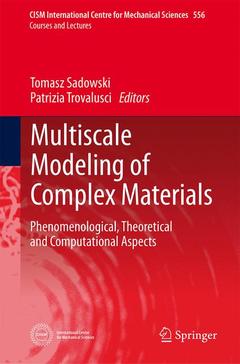Description
Multiscale Modeling of Complex Materials, 2014
Phenomenological, Theoretical and Computational Aspects
CISM International Centre for Mechanical Sciences Series, Vol. 556
Coordinators: Sadowski Tomasz, Trovalusci Patrizia
Language: English
Subjects for Multiscale Modeling of Complex Materials:
Publication date: 09-2014
278 p. · 15.5x23.5 cm · Hardback
278 p. · 15.5x23.5 cm · Hardback
Description
/li>Contents
/li>Comment
/li>
The papers in this volume deal with materials science, theoretical mechanics and experimental and computational techniques at multiple scales, providing a sound base and a framework for many applications which are hitherto treated in a phenomenological sense. The basic principles are formulated of multiscale modeling strategies towards modern complex multiphase materials subjected to various types of mechanical, thermal loadings and environmental effects. The focus is on problems where mechanics is highly coupled with other concurrent physical phenomena. Attention is also focused on the historical origins of multiscale modeling and foundations of continuum mechanics currently adopted to model non-classical continua with substructure, for which internal length scales play a crucial role.
On the method of virtual power in continuum mechanics.- Higher gradient and micro-polar continua as specific cases.- Integrated multi-scale characterization and modeling of ductile failure in heterogeneous materials.- Fractals in mechanics of materials.- Modeling and experimental verification of damage and fracture processes of composites under mechanical and thermal loading.- Multi-scale modeling of damage and failure in composite materials.- Micro-damage mechanics, macro-damage mechanics, and synergistic damage mechanics.- Molecular approaches for multi-field continua: origins and actual developments with applications to fibre composites and masonry-like materials.
Compendium of advanced research on basic principles of multiscale modeling strategies for complex multiphase under mechanical and thermal loadings
Complex material behavior and microstructure are shown from several points of view: phenomenological, theoretical and computational
Multidisciplinary investigation (engineering, continuum mechanics, material science)
© 2024 LAVOISIER S.A.S.
These books may interest you

Multiscale Biomechanics 187.99 €



